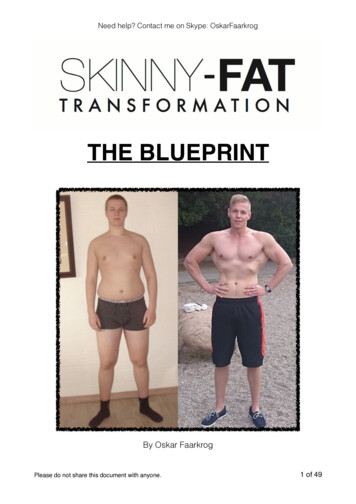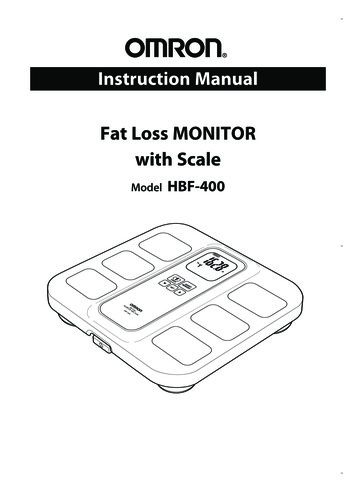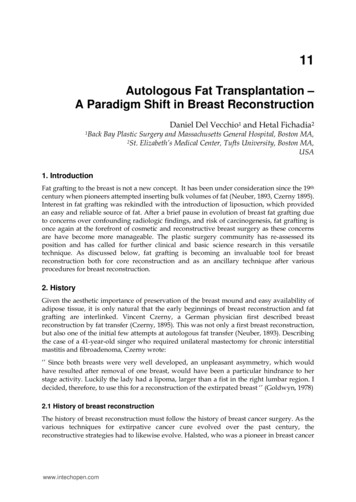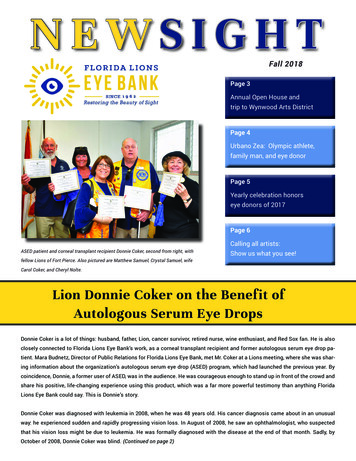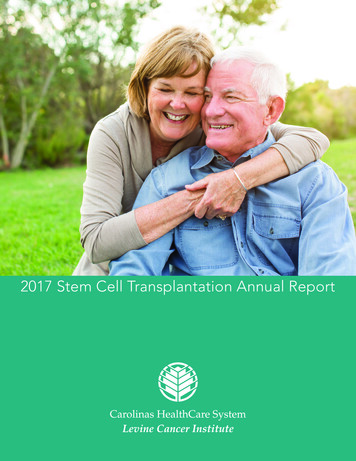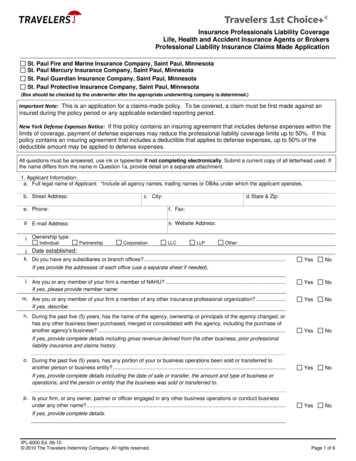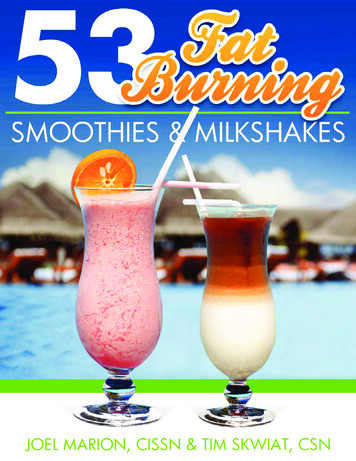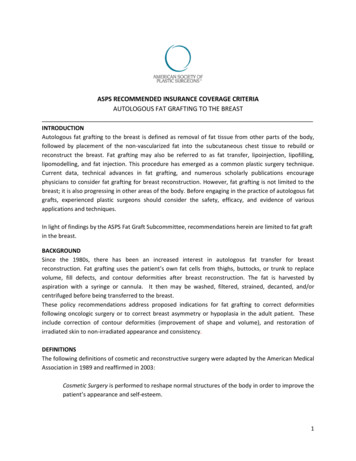
Transcription
ASPS RECOMMENDED INSURANCE COVERAGE CRITERIAAUTOLOGOUS FAT GRAFTING TO THE BREASTINTRODUCTIONAutologous fat grafting to the breast is defined as removal of fat tissue from other parts of the body,followed by placement of the non-vascularized fat into the subcutaneous chest tissue to rebuild orreconstruct the breast. Fat grafting may also be referred to as fat transfer, lipoinjection, lipofilling,lipomodelling, and fat injection. This procedure has emerged as a common plastic surgery technique.Current data, technical advances in fat grafting, and numerous scholarly publications encouragephysicians to consider fat grafting for breast reconstruction. However, fat grafting is not limited to thebreast; it is also progressing in other areas of the body. Before engaging in the practice of autologous fatgrafts, experienced plastic surgeons should consider the safety, efficacy, and evidence of variousapplications and techniques.In light of findings by the ASPS Fat Graft Subcommittee, recommendations herein are limited to fat graftin the breast.BACKGROUNDSince the 1980s, there has been an increased interest in autologous fat transfer for breastreconstruction. Fat grafting uses the patient’s own fat cells from thighs, buttocks, or trunk to replacevolume, fill defects, and contour deformities after breast reconstruction. The fat is harvested byaspiration with a syringe or cannula. It then may be washed, filtered, strained, decanted, and/orcentrifuged before being transferred to the breast.These policy recommendations address proposed indications for fat grafting to correct deformitiesfollowing oncologic surgery or to correct breast asymmetry or hypoplasia in the adult patient. Theseinclude correction of contour deformities (improvement of shape and volume), and restoration ofirradiated skin to non-irradiated appearance and consistency.DEFINITIONSThe following definitions of cosmetic and reconstructive surgery were adapted by the American MedicalAssociation in 1989 and reaffirmed in 2003:Cosmetic Surgery is performed to reshape normal structures of the body in order to improve thepatient’s appearance and self-esteem.1
Reconstructive Surgery is performed on abnormal structures of the body, caused by congenitaldefects, developmental abnormalities, trauma, infection, tumors or disease. It is generallyperformed to improve function, but may also be done to approximate a normal appearance.SCIENTIFIC EVIDENCEAn evaluation of available literature on autologous fat grafting following mastectomy with no remainingnative breast tissue indicates that the body of evidence is comprised mostly of case series, and whencombined, the studies provide consistent evidence, thus resulting in grade B recommendations. A gradeB recommendation encourages clinicians to employ the available information while remaining cognizantof newer, evidence-based findings. The existing evidence suggests autologous fat grafting is an effectiveadjunct to breast reconstruction following mastectomy demonstrating moderate to significant aestheticimprovement. In addition, the available evidence also cites autologous fat grafting as a useful modalityfor alleviating post mastectomy pain syndrome. Furthermore, the evidence suggests autologous fatgrafting as a viable option for improving the quality of irradiated skin present in the setting of breastreconstruction.INSURANCE COVERAGE SUMMARYInsuranceFat Grafting Fat Grafting Coverage Criteria ExplanationcompanyCoverageAetnaYesGrafting of autologous fat as a replacement for implants for breastreconstruction, or to fill defects after breast conservation surgery orother reconstructive techniques is considered medically necessary,includes lipectomy and liposuction.AnthemNoN/AInformationAvailableBlue CrossNoThe use of autologous fat grafting to the breast, with or withoutBlue Shieldadipose-derived stem cells, is considered investigational.CignaNoAutologous fat transplanting (lipoinjection, lipolifting, lipomodelling,ADSCs) following breast reconstruction procedures is not coveredbecause such treatment is considered experimental, investigational orunproven.CoventryNoN/AInformationAvailableHealth NetYesAutologous fat/graft transfer (e.g. lipoinjection, lipofilling,lipomodelling) post-mastectomy, when no native breast tissue ispresent, is considered medically necessary.HumanaNoHumana members MAY NOT be eligible for autologous fat graft, fattransplant (lipoinjection, lipomodeling), suction lipectomy orliposuction in conjunction with breast reconstruction. Thesetechnologies are considered experimental/investigational.United Health NoN/AGroupInformation2
AvailableAs the above table indicates, most insurance companies continue to consider fat grafting not “medicallynecessary” and will not reimburse for any procedure related to fat grafting. As such, members shoulddevelop a “self-pay” package for this service outlining the cost of the procedure to include pre/postoperative care, surgeon and anesthesiologist fees, cost of drugs and supplies, etc. Members should alsodiscuss the lack of coverage with their state Attorneys General (AG) office and solicit furtherinvestigation by their AG to ensure coverage for fat grafting under the federal mandate for breast cancerreconstruction services.POLICYAutologous fat grafting should no longer be considered experimental but should be regarded as part ofreconstructive surgery when it is performed to approximate a normal appearance of the breastsfollowing mastectomy or lumpectomy or in patients with asymmetry or hypoplasia of other origins.Breast reconstruction of the affected breast, as well as surgery on the contralateral breast to achievesymmetry, is considered reconstructive surgery and in accordance with the Women’s Health and CancerRights Act must be a covered benefit and reimbursed by third-party payers.Legislation: Women’s Health and Cancer Rights Act of 1998.In October 1998, federal legislation was signed into law requiring group health plans and health issuersthat provide medical and surgical benefits with respect to mastectomy, to cover the cost ofreconstructive breast surgery for women who have undergone a mastectomy. The law states: The attending physician and patient are to be consulted in determining the appropriate type ofsurgery. Coverage must include all stages of reconstruction of the diseased breast, procedures to restoreand achieve symmetry on the opposite breast and the cost of prostheses and complications ofmastectomy, including lymphedema.Group health plans and health insurance issuers offering group health coverage may not: Deny a patient eligibility, or continued eligibility, to enroll or to renew coverage under the termsof the plan, solely for the purpose of avoiding the requirements of the statute. Penalize, reduce, or limit the reimbursement of an attending provider. Provide incentives to attending provider to induce such provider to provide care to an individualparticipant or beneficiary in a manner inconsistent with this section.CODING & BILLINGThe following codes are provided as a guideline for the physician and are not meant to be exclusive ofother possible codes.ProcedureGrafting of autologous fat harvested by liposuctiontechnique to trunk, breasts, scalp, arms, and orlegs; 50 cc or less injectateEach additional 50 cc injectate, or part thereof (Listseparately in addition to code for primaryprocedure)CPT Code(s)15771RVUsRVU 6.7315772RVU 2.53
Diagnosis codesAcquired absence of breastAtrophy of breastBreast asymmetry/ disproportionof reconstructed breastBreast cancerCongenital malformationof breastDeformity ofreconstructed breastEncounter for breastreconstruction followingmastectomyGenetic susceptibilityto malignant neoplasmHistory of breast cancerHypoplasia of breastLate effects of medical/surgicalcareLate effects of radiationScar, fibrosisICD-9 codeV45.71611.4612.1ICD-10 codeZ90.10 – Z90.13N64.2N65.1174.0 - 174.9757.6C50.011 – C50.929Q83.0 – s/Other-InsuranceProtections/whcra plans/womens.htmBonomi R, Betal D, Rapisarda IF, Kalra L, Sajid MS, Johri A.Role of lipomodelling in improving aestheticoutcomes in patients undergoing immediate and delayed reconstructive breast surgery. Eur J SurgOncol. 2013 Oct;39(10):1039-45.Caviggioli, F., Maione, L., Forcellini, D. et al. Autologous fat graft in postmastectomy pain syndromePlast. Reconstr. Surg.128: 349-352, 2011.de, B.C., Momoh, A.O., Colakoglu, S. et al. Evaluation of clinical outcomes and aesthetic results afterautologous fat grafting for contour deformities of the reconstructed breast Plast. Reconstr. Surg. 128:411e-418e, 2011.Delay, E., Sinna, R., Delaporte, T. et al. Patient information before aesthetic lipomodeling(lipoaugmentation): a French plastic surgeon’s perspective Aesthet. Surg. J. 29: 386-395, 2009.Kanchwala, S.K., Glatt, B.S., Conant, E.F. et al. Autologous fat grafting to the reconstructed breast themanagement of acquired contour deformities Plast. Reconstr. Surg. 124: 409-418, 2009.4
Kaoutzanis C, Xin M, Ballard TN, Momoh AO, Kozlow JH, Brown DL, Cederna PS, Wilkins EG. Outcomes ofautologous fat grafting following breast reconstruction in post-mastectomy patients. Plast ReconstrSurg. 2014 Oct;134(4 Suppl 1):86-7.Longo B, Laporta R, Sorotos M, Pagnoni M, Gentilucci M, Santanelli di Pompeo F. Total BreastReconstruction Using Autologous Fat Grafting Following Nipple-Sparing Mastectomy in Irradiated andNon-irradiated Patients. Aesthetic Plast Surg. 2014 Oct 16.Losken, A., Pinell, X.A., Sikoro, K. et al. Autologous fat grafting in secondary breast reconstruction Ann.Plast. Surg. 66: 518-522, 2011.Panettiere, P., Marchetti, L., Accorsi, D. The serial free fat transfer in irradiated prosthetic breastreconstructions Aesthetic Plast. Surg.33: 695-700, 2009.Pérez-Cano R1, Vranckx JJ, Lasso JM, Calabrese C, Merck B, Milstein AM, Sassoon E, Delay E, WeilerMithoff EM. Prospective trial of adipose-derived regenerative cell (ADRC)-enriched fat grafting forpartial mastectomy defects: the RESTORE-2 trial. Eur J Surg Oncol. 2012 May;38(5):382-9.Petit, J.Y., Botteri, E., Lohsiriwat, V. et al. Locoregional recurrence risk after lipofilling in breast cancerpatients Ann. Oncol. 2011.Ribuffo, D., Atzeni, M., Serratore, F. et al. Cagliari University Hospital (CUH) protocol for immediatealloplastic breast reconstruction and unplanned radiotherapy. A preliminary report Eur. Rev. Med.Pharmacol. Sci. 15: 840-844, 2011.Rietjens, M., De, L.F., Rossetto, F. et al. Safety of fat grafting in secondary breast reconstruction aftercancer J. Plast. Reconstr. Aesthet. Surg. 64: 477-483, 2011.Rigotti, G., Marchi, A., Stringhini, P. et al. Determining the oncological risk of autologous lipoaspirategrafting for post-mastectomy breast reconstruction Aesthetic Plast. Surg. 34: 475-480, 2010.Sarfati, I., Ihrai, T., Kaufman, G. et al. Adipose-tissue grafting to the post-mastectomy irradiated chestwall: preparing the ground for implant reconstruction J. Plast. Reconstr. Aesthet. Surg. 64: 1161-1166,2011.Serra-Renom, J.M., Munoz-Olmo, J.L., Serra-Mestre, J.M. Fat grafting in postmastectomy breastreconstruction with expanders and prostheses in patients who have received radiotherapy: formation ofnew subcutaneous tissue Plast. Reconstr. Surg. 125: 12-18, 2010.Seth, A.K., Hirsch, E.M., Kim, J.Y., Fine, N.A. Long-term outcomes following fat grafting in prostheticbreast reconstruction: a comparative analysis. Plast. Reconstr. Surg. 130: 984-90, 2012.5
Sinna, R., Delay, E., Garson, S. et al. Breast fat grafting (lipomodelling) after extended latissimus dorsiflap breast reconstruction: a preliminary report of 200 consecutive cases J. Plast. Reconstr. Aesthet.Surg. 63: 1769-1777, 2010.Weichman KE1, Broer PN, Tanna N, Wilson SC, Allan A, Levine JP, Ahn C, Choi M, Karp NS, Allen R. Therole of autologous fat grafting in secondary microsurgical breast reconstruction. Ann Plast Surg. 2013Jul;71(1):24-30.Approved by the ASPS Executive Committee: June 2015. Coding updated in January 2020.6
As the above table indicates, most insurance companies continue to consider fat grafting not "medically necessary" and will not reimburse for any procedure related to fat grafting. As such, members should develop a "self-pay" package for this service outlining the cost of the procedure to include pre/post-

